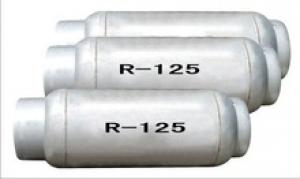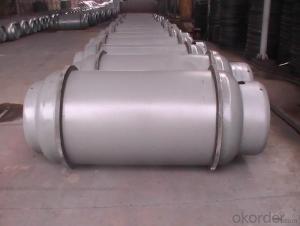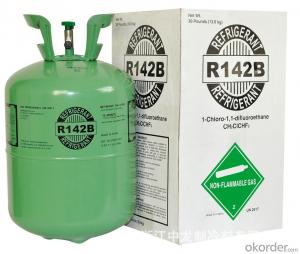R141b
- Loading Port:
- Shanghai
- Payment Terms:
- TT OR LC
- Min Order Qty:
- -
- Supply Capability:
- 1000MT m.t./month
OKorder Service Pledge
OKorder Financial Service
You Might Also Like
Specifications
Good Quallity;
Competitive Price;
Cleaning Agent;
Foaming Agent
Dichlofluoroethane(R141b)
R141b (HCFC-141b) is the leading substitute blowing agent for CFC-11 in rigid foam insulation materials which are widely used for residential and public constructions, home applications and transport vehicles.
Properties:
Index | Unit | R141b |
Chemical formula |
| CH3CCl2F |
Molecular weight | g/mol | 117.0 |
Boiling Point 101.3 KPa(°C) | °C | 32.1 |
Freezing Point 101.3 KPa(°C) | °C | -103.5 |
Critical Pressure | KPa | 4640.2 |
Critical Temperature (°C) | °C | 210.2 |
Saturated liquid density (25°C) | Kg/m3 | 1227 |
Specific heat (25°Cliquid) | KJ/kg·k | 1.17 |
ODP |
| 0.11 |
GWP |
| 0.09 |
Quality Specification:
Index | Quality Performance |
Appearance | Bright & Clear Liquid |
Odor | No strange stench |
Purity %≥ | 99.9% |
Moisture %≤ | 0.005 |
Acidity(as HCL) %≤ | 0.00001 |
Evaporation residue %≤ | 0.01 |
Chlorides(Cl-) test %≤ | 0.0003 |
R141b Packing: 13.6kg/30lb; 30kg, 250kg drum.
- Q: What is the difference between an aromatic compound and a hydrocarbon derivative?
- The aromatic compound is a benzene ring containing compound, which may be a hydrocarbon or a hydrocarbon derivative. Hydrocarbons are hydrocarbon-containing compounds, and hydrocarbons containing hydrocarbons other than hydrocarbons are derivatives of hydrocarbons. The two concepts have crossed.
- Q: Is carbon monoxide an organic gas?
- Carbon dioxide is highly toxic. It is a strong ability to combine blood hemoglobin, which leads to cell hypoxia and suffocation. At present, if the trace carbon monoxide environment work, do not wear a gas mask and other necessary, it is recommended to eat more iron and calcium foods to reduce the harm to the body.
- Q: The functional group of the derivative of the hydrocarbon
- Yes, the number of carbon after a certain, only to determine the nature of the functional group. This is also the reason for the name of the functional group
- Q: Such as the problem, and how, how to squeeze methane into liquid, or how to squeeze into the liquid gas? It is still very difficult ... there is a dangerous thing .... (this is not important) high reward
- Pentane, g, x, n, decane, to eleven to hexadecane are liquid hydrocarbons. Ethanol is not a hydrocarbon, it is aerobic. Polymeric material is a compound of relatively high molecular weight Composition of the material, there are many, such as rubber, plastic, fiber, paint
- Q: What are the inorganic compounds
- The inorganic compound is a compound other than an organic compound. Organic compounds are organic matter containing C (carbon), in addition to CO2, carbonated, carbonate-containing.
- Q: What is the difference between organic matter and inorganic matter?
- Organic matter that organic compounds. Carbon compounds (carbon monoxide, carbon dioxide, carbonates, metal carbides and other rare carbon compounds excluded) or hydrocarbons and their derivatives in general. Organic matter is the material basis for life.
- Q: Is the system name of a hydrocarbon derivative named if the question can be named according to the nomenclature of the alkane?
- No, aldehyde is functional group, must be aldehyde for the mother. In addition, when the aldehyde group is a substituent, it is named as a formyl group.
- Q: What is the definition of organic matter
- Organic matter usually refers to carbon-containing compounds, or hydrocarbons and their derivatives are collectively referred to as organic compounds.
- Q: Is the number of hydrogen atoms in the hydrocarbon or hydrocarbon derivative molecule be even
- The number of hydrogen atoms in the hydrocarbon must be even.
- Q: Rush! Hydrocarbon and hydrocarbon derivatives system information includes chemical formula, common name, Chinese name and so on
- hydrocarbon
Send your message to us
R141b
- Loading Port:
- Shanghai
- Payment Terms:
- TT OR LC
- Min Order Qty:
- -
- Supply Capability:
- 1000MT m.t./month
OKorder Service Pledge
OKorder Financial Service
Similar products
Hot products
Hot Searches





















